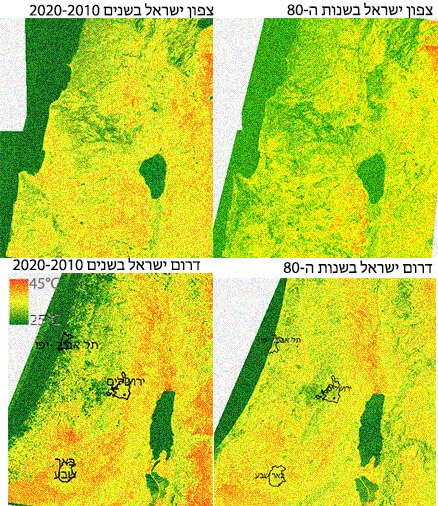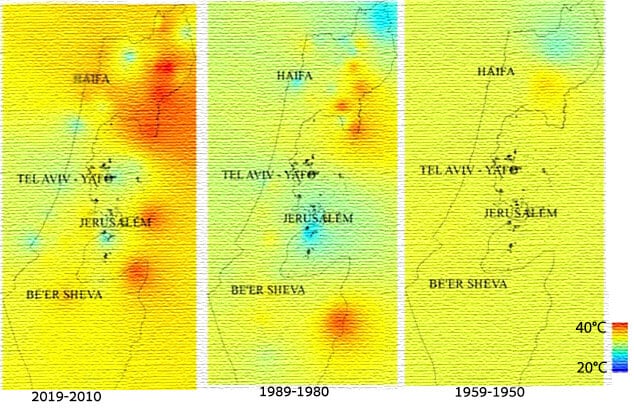According to a new Israeli study conducted at the Technion, heat stress - the oppressive combination of temperature and humidity - is only increasing in Israel. Just like we all feel. It's not "just" unpleasant - it's also very unhealthy in the long run
"Summer is coming and it's hot again", minister ארי Einstein more than fifty years ago. And here, summer is coming again and it's hot again - and much hotter, as we all feel. The climate crisis has already resulted in an increase in the maximum daily temperature inכ-2 degrees Celsius ב-30 The years The latest in Israel. But the temperature is only one part of the hot summer story. The second part, and no less oppressive, is the humidity. When the temperature and the humidity join hands and go out in a sticky dance, we feel the familiar and menacing combination of words "heat stress" - the index Official of the meteorological service which expresses the Degree an island-the convenience which results from the combination between the air temperature and the humidity found in it. The reason: the higher the humidity, the harder it is for our body to cool itself through sweating.
In a new Israeli study that was recently presented at the "Water and Environmental Engineering in the Face of Climate Change" conference of the Technion's Faculty of Civil and Environmental Engineering, data from ground measuring stations of the Israel Meteorological Service and information from an American observation satellite were used to map the average heat load during the midday hours of July August in Israel from the 70s until today. The study showed how exposed we are to heat stress and illustrated that everything Eric Einstein sings and we feel is true: heat stress is getting worse in all parts of the country (and especially in the north).
Heat stress is not "just" an uncomfortable matter - it is also very unhealthy. as per organization Health World, Overexposure to heat causes serious physiological effects, aggravates existing health problems such as respiratory and cardiovascular diseases and particularly adversely affects the elderly, children and pregnant women.
According to the organization, heat events in the world are increasing in intensity, frequency and duration due to the climate crisis. Particularly memorable events are wave the heat that hurt in Europe ב-2003 and caused 70 thousand deaths, the heat wave thataffliction in Russia ב-2010 and caused 56 thousand deaths, and the heat wave exceptional which hit in 2021 in North America.
Weakens the body, increases morbidity
The dangers of extreme and short-term heat waves are obvious, but the health effects of prolonged exposure to heat stress are no less dangerous. Review Article published last year compiled recent studies on the subject and showed that long-term exposure to high heat exerts heavy pressure on the health, well-being, and general functioning of the population.
"Heat stress weakens the body," explains Prof. David Brodai from the Faculty of Civil and Environmental Engineering at the Technion, who headed the new study with Dr. Rakfat Shafaran-Nathan. "While it is easy to distinguish and investigate short-term extreme temperature events, it is also possible that a high heat load that continues over many decades increases the morbidity and mortality of the population."
Brodai came to deal with the heat load in Israel completely by accident. He even wanted to investigate air pollution. In 2015, he distributed dozens of sensors in four neighborhoods in Haifa, near the Technion, with the aim of measuring different types of air pollution concentrations and finding their source. Besides pollution data, the sensors also collected temperature and humidity data.

"We noticed," says Broday, "that during 82 percent of the daytime hours of July-August, the residents of the tested areas were exposed to heat stress which, according to theNOAA (US National Oceanic and Atmospheric Administration) poses a health risk."
The unusual findings brought Brodai's research group to the second phase of the research: they decided to check more than the four neighborhoods in Haifa, and not just the summer of 2015 (which was particularly hot). The researchers moved on to examine data of the service the meteorological Israeli conflict, which are collected in ground measurement stations throughout Israel and which have been collected since the 50s. The researchers looked at the average heat load at two o'clock in the afternoon in the months of July-August in each decade, and used the models to build spatial maps of the heat loads.
The results were clear. "We saw how the heat load increased over the years," describes Brodai. "This is something that I feel and experience from the height of my years even without scientific evidence - but now you can actually show the changes from decade to decade." In addition, the data showed that the heat load is consistently higher in the north of Israel, due to the higher humidity that prevails in the region.
In the third phase of the research, Barudai and Shafran-Nathan began to use satellite data Landsat American, which has been active since the 70s and measures soil temperature data with a spatial resolution of 30 meters. These data were integrated into maps produced from the meteorological service data. The combination confirmed the study's conclusions. "The maps we received by merging the two databases," says Brodai, "are much richer: they show the heat load with a detailed resolution of 30 meters, so that conclusions can be drawn not only at the neighborhood level, but also at the street, building, and even individual person level ".
Protect from the heat with a few simple actions
The data presented are currently only preliminary results, but they are of course a big cause for concern - certainly when you take into account Forecasts pessimism From previous studies that speak of a warming of up to 3 more degrees in Israel by 2050, with the possibility of extreme heat loads that may reach up to a temperature that will feel like 61 degrees Celsius during the summer months. In other words, the exposure to high and prolonged heat loads is expected to increase even more in the future, and may lead to a serious health cost for all of us.
what can we do? Of course, above all, we need urgent global mobilization to address the climate crisis. However, there are also local ways to alleviate the heat load, mainly in the urban area: use of shading, wind corridors and trees (Only by themselves can bring Download of 4-2 degrees Celsius in their immediate environment), and more.

The detailed maps produced by Brodai and his partner can also help. "With this kind of resolution", Brodai explains, "it is possible to draw important health conclusions: it is possible to literally follow the daily walking route of a family or a person and calculate a heat exposure index for them".
According to him, public health researchers will be able to use these maps and examine them against the distribution of diseases such as asthma and even cancer, to examine the effects of long-term heat stress on health.
Brodai hopes that the maps obtained during the new research can help in sustainable urban planning that will reduce the harmful effects of heat loads in the future. "They can be used for future planning of energy infrastructures that are required to merge built spaces, for forecasting drinking water consumption and for planning shaded areas."
In a sun-struck country with no shade in the urban space like ours, one can only hope - and in fact, it should be demanded - that the decision-makers at the municipal and national level will take the simple actions that can protect our health and well-being in the public space.
More of the topic in Hayadan:
